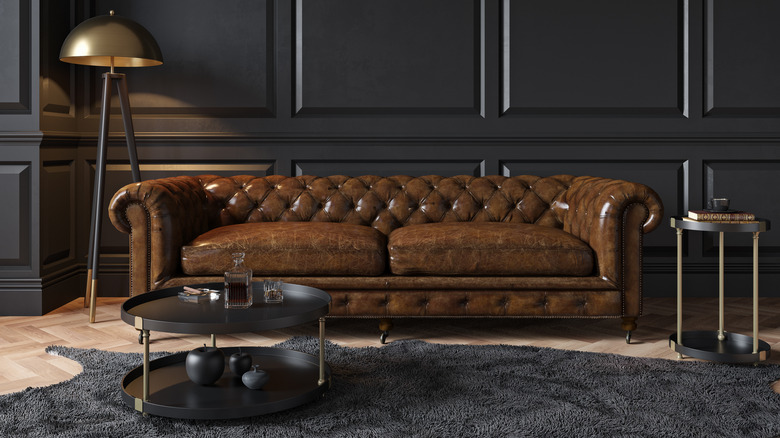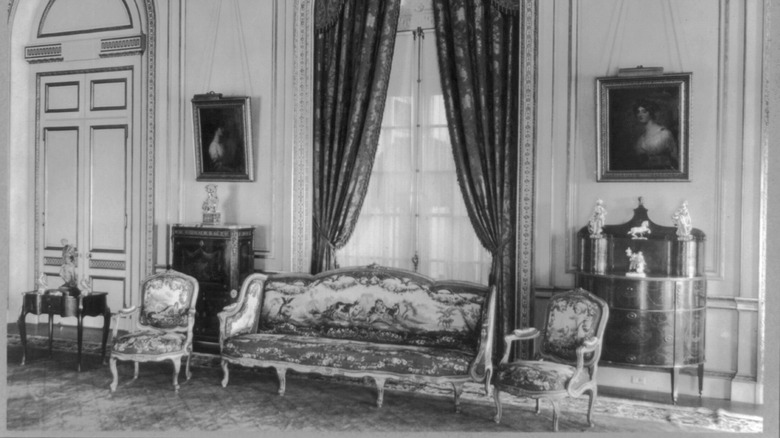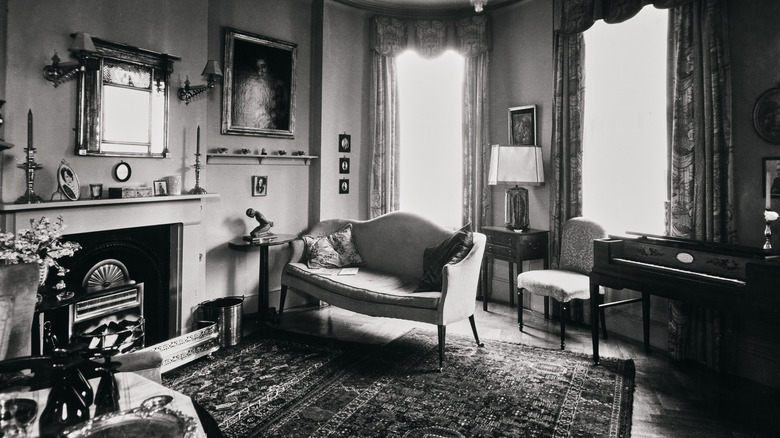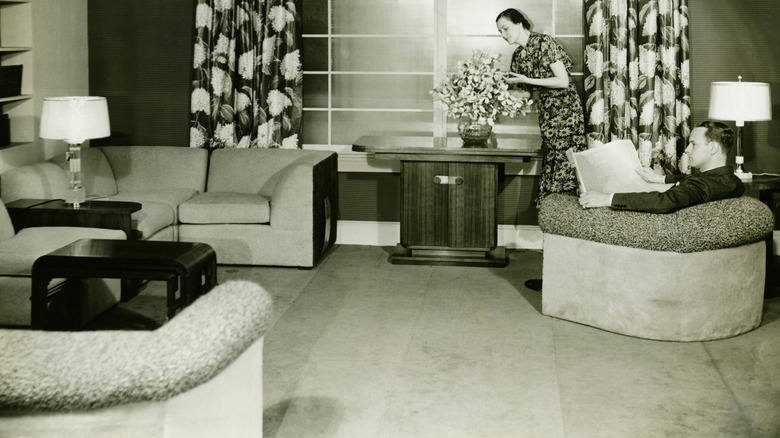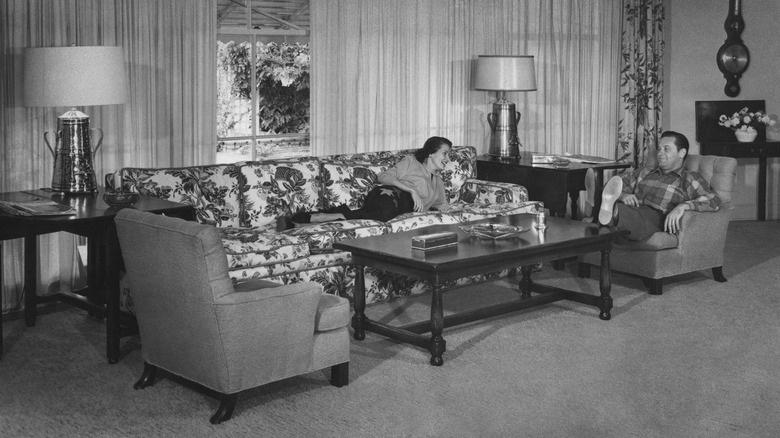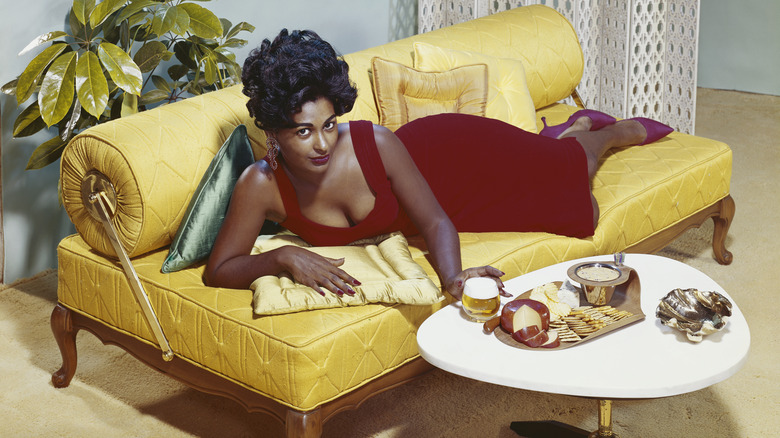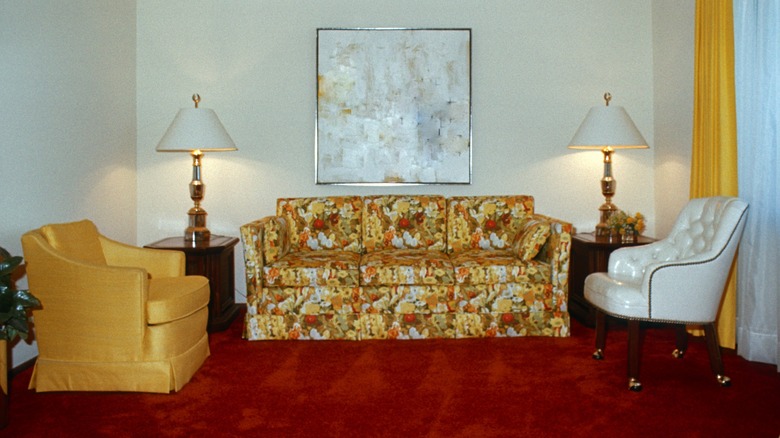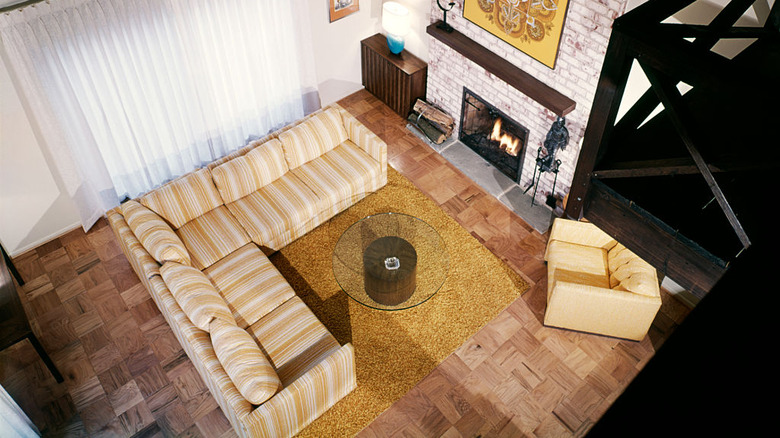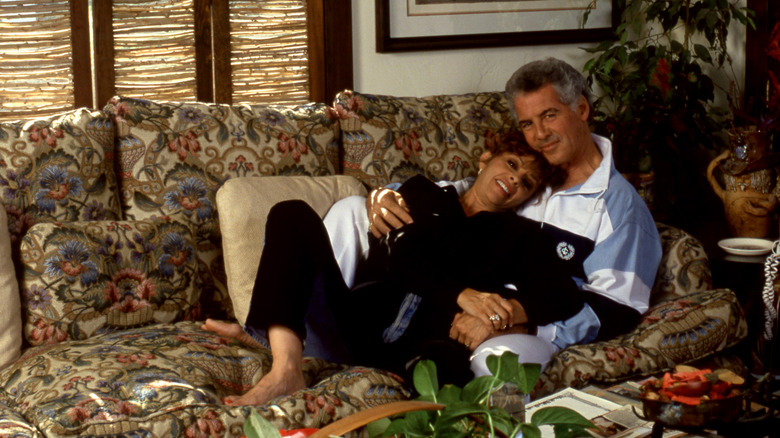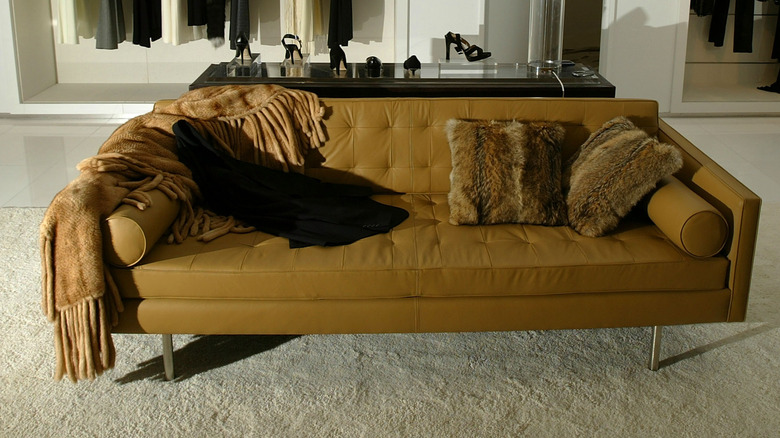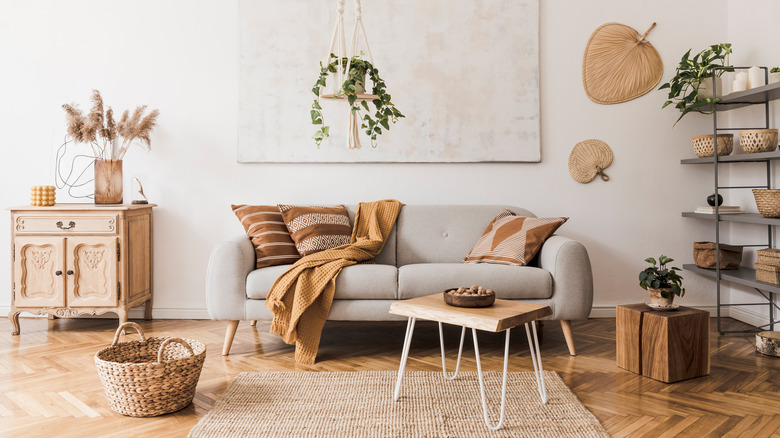Unique Sofa Styles That Made A Splash In Decades Past
Although Jay Wellingdon Couch is credited with officially creating the sofa in 1895, versions of this upholstered wonder date back much further in history. In fact, noble women in 16th-century France added material and padding to their wooden bench designs to provide comfort and improved lounging. This transferred into home furnishings and now the sofa serves as a centerpiece in living spaces all over the world.
The sofa has undergone some daring and exciting transformations in the decades since it first appeared in homes. Now, in 2023, sofa trends include curved upholstery, bright colors, and multifunctional seating, all drawing their inspiration from sofa designs of the past. They might be updated or reimagined, but the source material comes from decades that created these styles, sometimes out of necessity.
Whether you realize it or not, sofa styles have become synonymous with past eras. From the Chesterfield sofa of the Victorian era all the way through to the floral prints that swept homes in the nineties. Let's look at all the styles that have come to define decades past.
The roaring '20s
As its moniker suggests, this was the era of decadence. For many Americans, the '20s ushered in a new age; it was the first experience of city life for many rural dwellers. This decade also marked the start of a new consumer-driven economy that saw women becoming more financially independent. Advertising, music, and film were broadcast to more people this decade than ever before. It was a decadent time and the prohibition of alcohol only drove it underground; thus, speakeasies were birthed.
These changes weren't only reflected in nightlife; interior design saw a shift from more reserved decor to the decidedly more riotous elements that make up artful decor. Materials such as rich velvet, combined with bejeweled sculptures, are among some of the key elements of interior design in the roaring '20s. Sofas combined these details with colonial revival styles originating from the late 1800s, for the ultimate decadent seating experience. These sofas and chaise longues combined velvet fabrics in deep hues of blues, greens, purples, and blacks, and used oak, mahogany, or walnut trimmings. These often featured elegant curvature in the legs and crown that resembled sculptures.
The Great Depression of the '30s
Unfortunately, the indulgence of the '20s was rather short-lived, as by the next decade, a financial crisis hit. The '30s is well known as the era of The Great Depression. This drastic shift from decadence to function meant that design, fashion, and architecture were impacted in interesting ways. As people's spending habits were curbed, so too was the demand for opulence. However, art deco wasn't completely, or suddenly, discarded, it just underwent a bit of refinement. Practicality and comfort took center stage, a concept we still see in sofas today.
It took a few years before more industrialist ideals took over. But by the mid-30s, the machine age had begun to take hold. This meant simpler design and sleeker lines. One of the most notable designs of the era was the German Bauhaus decor, which exemplified minimalist living by focusing on sofas as practical features rather than works of art. As more German designers and craftspeople emigrated to the United States, so too did their design influences. Sofas became more angular and featured more metal during this era as this focused on mass production, a key attraction in turbulent financial times.
The war years of the '40s
As the war began to impact American life post-Pearl Harbor, even more changes to lifestyle and design began to take hold. Functionality, which started to impact fashion and interior design in the '30s, had now become necessary. There was such a shortage of basic raw materials in the United States that the government placed a restriction on how much fabric was available for clothing for everyday people. As for furniture, more designs were made using materials such as nylon. The '40s were an in-between decade that transitioned from minimalist, functional living to markers of post-war affluence.
Living spaces mirrored subdued attitudes surrounding wartime, with warm hues of blues, greens, and dark oranges. With limited resources, colonial and bentwood became the two most common furniture styles, both favoring clean lines, with the latter being preferred for seating furniture. Sofas began to shift more towards modular — also known as sectional — sofa designs. These were more accessible to the general public as they could be bought in sections according to available income. Midway through the decade, the war ended. The celebratory spirit ushered in a new approach to style and amplified mid-century modernism in interior design. Post World War II, sofa styles didn't do away with functionalism but infused more playful energy into designs.
Welcome to the '50s
The '50s signaled an era of renewed hope, affluence, and structure in a way that previous years couldn't. With the Great Depression and the Second World War finally over, people were returning to a semblance of normalcy in their daily lives and wanted to maintain that in all aspects. With more earning potential post-war and economic downturn, more Americans could afford suburban homes and therefore enjoy more space.
Increasingly, families spent more time at home, especially in the evenings. They clamored in front of the TV to watch the latest shows. The idea of leisure entertainment, which had been lost somewhat in the wartimes of the '40s, was back, and that quest to maintain a structured, normal life impacted interior design. Comfort was key in '50s homes, and sofas evolved to meet those needs. Mid-century modernism was the key style during this time, ushering in a new timeless design style still popular today. This included simplistically-designed and low-profile sofas that were as visually pleasing as they were functional. Partially inspired by Scandinavian designs, clean, straight lines were paired with colors that pop — yellows and reds, for example. Also popular during this time were Queen Anne sofas and Chippendale chairs.
The swingin' '60s
The '60s rebelled against the quiet and subdued lifestyle that swept the '50s. Youths rebelled against societal norms that excluded and often vilified women and people of color. Rock and roll became inescapable as more conservative music faded into swift obscurity. Fashion and interior design became louder, bolder, and much busier. The '60s took its inspiration from '50s home decor but then turned it on its head. The colors of many homes seemed to reflect the impassioned revolution outside. Bright oranges, blues, and in-your-face patterns and designs became a sort of signifier of the time.
Anything was possible in the '60s. Space exploration captured the attention of many, thanks to NASA's voyage to the moon. Interior design took on a sci-fi element that extended to furnishings, taking classical forms and redefining them more modernly. In the case of the '60s, it took the designs created in the '40s, popularised in the '50s, and turned into a new-age style that featured quirkier, curvier shapes, and lots of color-blocking. Revolutionary designs aside, the key themes of the '60s were comfort and relaxation for all. As people took to hosting, comfort began to play a key role in how sofas were designed. The '60s saw the popularization of conversation pits – which are essentially seating in a sunken floor — as well as sofas with fatter arms and rounder backs and all-around plushier seating options for all.
The groovy '70s
What began in the '60s became fully fleshed out in the '70s. The hippie movement continued alongside much of the activism that began the prior decade. The Vietnam War began, and clashes between the left and right became more commonplace. Popular culture, particularly film, had begun to build a rising cult following that spilled into everyday life.
Interior design seemed to account for the diversity of tastes and interests from the '70s. Environmental causes were at the forefront and interior decor mirrored the trend. Nature, wicker, and open-plan spaces took hold of many living rooms, and eco-friendly decor like wicker and macrame infused an outdoorsy feel. Natural materials, nature-inspired designs, and earthy colors all took the '70s by storm as the Earth movement gained momentum.
Where sofas were concerned, the '70s prioritized lounging. Guests were not only encouraged but almost forced to sink into the couches thanks to their plush and over-stuffed nature — a style that began to take hold in the '60s. With corner-to-corner seating becoming increasingly popular with the conversation pits, one could argue that relaxation was taken even more seriously in the '70s. Another key component of the sofa styles was the boldness of pattern choices. Designers of the era were not afraid to play with various prints and patterns.
The colorful '80s
The '80s marked a shift from mid-century modernism to postmodernism – the art of putting a modern twist on classical designs and styles. Though many of the curvier styles began to fade in the early '80s, this era still worked with rounded furniture. Young urban professionals with cash to spare took over the city, and consumerism took hold of the decade. Though it started in the '60s and '70s, pop art and neo-pop were still forces to be reckoned with in the '80s, especially in interior design. This love for color was known as the Memphis Design style, a blend of art deco and pop art.
Alongside Memphis Design, popular amongst young creatives but proved too rebellious for everyone else, was the more refined use of metal in furniture. IKEA presented an interesting solution with its Klippan sofa, which featured a colorful cover that could be changed. So as the decade progressed and the Memphis Design movement began to fall out of favor, the Klippan sofa allowed homeowners to shift with the times without breaking the bank. By the middle of the decade, more refined, cleaner-lined sofas were all the rage.
The hip '90s
Some might say we reached a fevered pitch in the '80s. The nineties reeled it back in – or perhaps redistributed its postmodernist ideals. This was the era of minimalism. Sure, when we look back on the decade, it feels like the opposite was true, but compared to the '80s, it was muted. On one hand, some homeowners opted for less color, instead using white and beige as their base. For others, however, it was an explosion of print and patterns. Some had gone full leather for their sofas, while others still maintained their fabric sofas, adorning them with eye-catching patterns in interesting colorways.
This decade experienced an identity crisis of sorts. In fact, '90s interior design might be one thing or another, depending on who you ask. To some, cult classics like American Psycho introduced a new type of sterile luxury living to an audience, featuring the Barcelona chair and white Birch Lane Heritage sofa for yuppies in the city. For suburbanites, however, one thing's true — floral prints and patterns were popular this decade. For others, the memory of plastic sofa covers is all too real. By the '90s, homes had made the shift from prioritizing hosting duties, at least in the way that previous decades. Living rooms were now almost exclusively designed to accommodate a family with kids, and larger, three-seater sofas were now more in demand. Also around this time, the La-Z-Boy chairs took over the decade as comfort (especially in front of the TV) became a priority for many Americans.
The new millennium
So much occurred at the start of the new millennium. While recovering from the Y2K scare, 9/11 happened. Technology had begun taking over more in daily life, and mobile phones were now more widely available. Luxury took on a different meaning during this decade as interests shifted from ostentatious to more understated. Silk and satin fabrics were not just limited to fashion but were also used in interior design for a more romantic approach to decor.
Romantic elements were also present in sofa design, shifting from angular designs to softer curves. Shabby chic decor was another trend that's become synonymous with the 2000s. Thrifting was becoming a popular way to find vintage gems, which informed how interior design evolved through the decade. This was a key component of the shabby chic trend as vintage was the element that tied everything together. In this decade, sofa slipcovers also became a popular way to redesign one's living space without investing in a new sofa.
The Minimalist 2010s
The gumbo pot of all the decades is synonymous with so many things: smartphones, social media, climate change activism, and yet another economic recession, which changed how we view everything. At the start of the decade, a mere year after the recession officially ended, pockets were still in recovery. This meant more people were looking for how to do more with less. Interior design was not exempt from this. DIY guides, shopping hacks, and creative approaches to home decor became more popular among frugal shoppers. Scandinavian designs took hold in the early third of the decade, with more people opting for budget-friendly items like IKEA decor and furniture.
Industrial chic was big in the early 2010s, and sofas were leaning more into the distressed leather look that is closely associated with this trend. However, by the mid-2010s, people were more interested in making their homes more welcoming. Plants and chevron prints flanked living areas in the home, alongside the lighter-colored sofas and woods. As the decade progressed, velvet sofas made a comeback in millennial pink and other bright colors.
